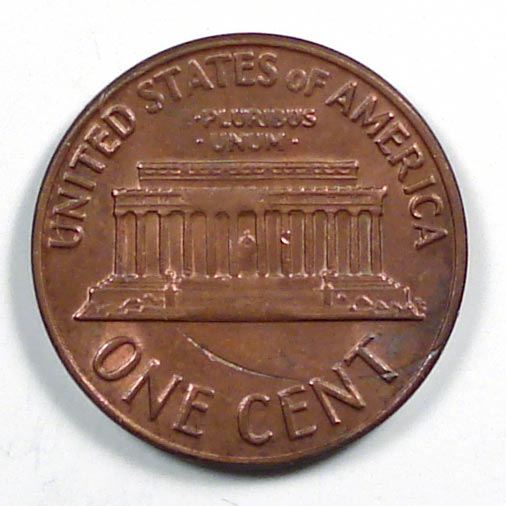Major error eye candy #8: Incomplete clip mystery dime?
An incomplete clip is formed when the blanking press fails to punch all the way through, creating a deep planchet-shaped indentation in the metal sheet. The sheet then advances partially and a second punch is successful. Coins struck on incomplete clips show a deep indentation on both sides, where the curvature of the indentation matches the curvature of the coin. This is an example of an incomplete clip:


This next coin is... something. I don't know what. It was described as a cud, which is definitely wrong. A cud is formed when part of one die breaks off entirely. There is a large raised area on one side of the coin where it flows unimpeded into the broken portion of the die, and a corresponding weakness on the other side where the broken die wasn't present to provide pressure. This coin shows weakness on the reverse side, but it doesn't show a raised area on the obverse, so it can't be a cud. What it does show is a deep curved impression that is very similar to what is seen on an incomplete clip. But in this case the curvature of the impression doesn't match the curvature of the dime. Also, there is weakness on the obverse as well as the reverse. And there isn't a matching curved mark on the reverse.
The weight is 2.242 grams, which is teensy bit light (should be 2.268 grams). I'm not convinced that little bit is significant.
Anyone have an explanation for what's happening with this one?


Earlier:
Major error eye candy #1: Edge strike, double struck
Major error eye candy #2: 125% struck through cloth
Major error eye candy #3: Struck through feeder finger
Major error eye candy #4: 1955 Double Date Lincoln Cent
Major error eye candy #5: Nonface strikes
Major error eye candy #6: Reeding struck through coin
Major error eye candy #7: Broadstrike with partial counterbrockage


This next coin is... something. I don't know what. It was described as a cud, which is definitely wrong. A cud is formed when part of one die breaks off entirely. There is a large raised area on one side of the coin where it flows unimpeded into the broken portion of the die, and a corresponding weakness on the other side where the broken die wasn't present to provide pressure. This coin shows weakness on the reverse side, but it doesn't show a raised area on the obverse, so it can't be a cud. What it does show is a deep curved impression that is very similar to what is seen on an incomplete clip. But in this case the curvature of the impression doesn't match the curvature of the dime. Also, there is weakness on the obverse as well as the reverse. And there isn't a matching curved mark on the reverse.
The weight is 2.242 grams, which is teensy bit light (should be 2.268 grams). I'm not convinced that little bit is significant.
Anyone have an explanation for what's happening with this one?


Earlier:
Major error eye candy #1: Edge strike, double struck
Major error eye candy #2: 125% struck through cloth
Major error eye candy #3: Struck through feeder finger
Major error eye candy #4: 1955 Double Date Lincoln Cent
Major error eye candy #5: Nonface strikes
Major error eye candy #6: Reeding struck through coin
Major error eye candy #7: Broadstrike with partial counterbrockage
0
Comments
Sean Reynolds
"Keep in mind that most of what passes as numismatic information is no more than tested opinion at best, and marketing blather at worst. However, I try to choose my words carefully, since I know that you guys are always watching." - Joe O'Connor
A retained cud would show weakness on the reverse, but would show a raised area (not weak) on the obverse. And a retained cud also wouldn't explain the curved mark.
It occurred to me overnight that I could measure the radius of the curved mark, so I've done that. The lengths are shown in pixels in the image, and my math says that the curved mark would form a circle that was 1.64x-1.9x as large as a dime, or 29.3mm-34mm. A half dollar is 30.6mm, comfortably in that range. So maybe this was punched from spoiled half dollar stock, rolled too thin for the half dollar blank to punch out a planchet and then fed a second time through a dime blanking press? Maybe?
Sean Reynolds
"Keep in mind that most of what passes as numismatic information is no more than tested opinion at best, and marketing blather at worst. However, I try to choose my words carefully, since I know that you guys are always watching." - Joe O'Connor
The thought of an incomplete clip half dollar and rolled thin to dime stock would be ultra cool!
By the way, I have a column on incomplete punch errors in the March 24 Coin World.